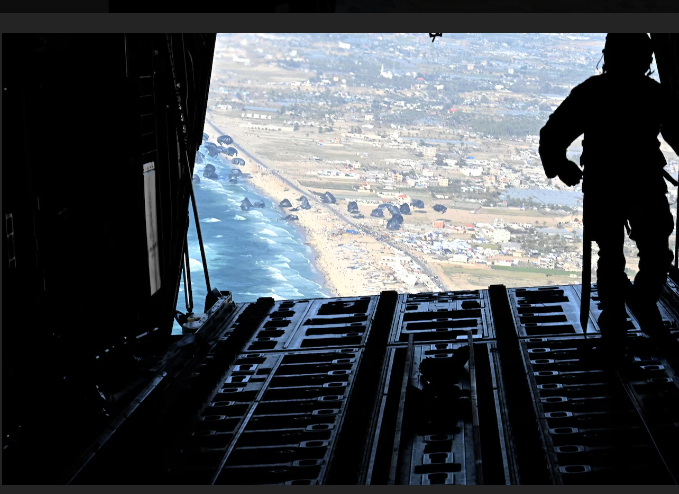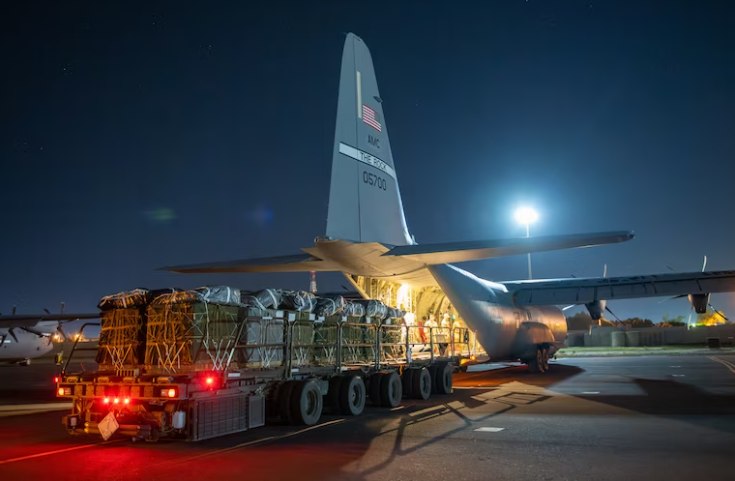
Whenever and wherever there is a humanitarian crisis caused by war, conflict, or brought about by natural disasters, the United States is there to deliver critical aid, by land, by sea and by air.
Oftentimes, “by air” is the only way to deliver lifesaving supplies to those in need as was the case during the Soviet Union’s blockade of Berlin in 1948-1949.
The historic and massive “Berlin Airlift” (also called “Operation Vittles”) saw the delivery by air of more than 2.3 million tons of food, medicine, fuel, machinery and other supplies to the two million beleaguered people in the Allied sectors of Berlin over a period of 11 months.
American aircraft and American aircrews made more than 189,000 flights, through “air corridors” into Berlin airspace, landing at several airfields in West Berlin.
As the humanitarian crisis in Gaza has continued to worsen since the Israel-Hamas war started on Oct. 7, the United Nations, the U.S. and other countries have been trying to deliver food, medicine and supplies by land to the Palestinian people, at least one-quarter of whom face starvation according to the United Nations.
Today, at an event to commemorate the 59th anniversary of “Bloody Sunday” in Alabama, U.S. Vice President Kamala Harris bluntly called the situation in Gaza a “humanitarian catastrophe.” “People in Gaza are starving. The conditions are inhumane and our common humanity compels us to act,” Harris said.
In the recent past, U.S. Air Force and USAID-contracted aircraft have landed at Al-Arish, Egypt, with hundreds of thousands of pounds of food for onward travel to Gaza by truck.
However, over time, even that flow of aid has been reduced to a trickle due to Israeli barring or strictly limiting the entry of food, water, medicine and other supplies into Gaza and due to the fact that aid trucks that do get into Gaza are “being shot at, looted and overwhelmed by hungry people.”
Last week more than 100 Palestinians were killed in Gaza City when chaos broke out and Israeli troops fired onto crowds of desperate Palestinians surrounding an aid convoy, trying to pull food and supplies off the trucks.
Faced with such issues, President Biden resorted to a method – called “air drop” or “air delivery” — the U.S. has successfully used many times in the past, in Afghanistan, Iraq, Haiti and other places.
On Saturday, U.S. Air Force and Royal Jordanian Air Force C-130 aircraft, in what is expected to be a recurring mission, performed such an arial delivery mission over Gaza.
Three C-130s dropped about 38,000 pre-packaged meals in southwest Gaza, on the beach along the territory’s Mediterranean coast.

While airdrops have an advantage over trucks because aid can be moved to where it is needed very quickly, they cannot match surface transportation in terms of volume.
White House National Security Advisor John Kirby emphasizes that such airdrops will be “a supplement to, not a replacement for moving things in by ground.”
Other U.S. officials agree that airdrops alone will not be sufficient to mitigate the humanitarian crisis and that the U.S. must continue to work to increase the amount of aid flowing through previously established routes while pursuing new routes to deliver assistance.
According to one official, “We’re looking at the land routes, we’re looking at a sea route, we’re looking at the air route to really ensure that we’re exploring every opportunity to get assistance in.”
Central Command, in addition to more and sustained airdrops, plans to get additional aid into Gaza “by expanding the flow of aid through land corridors and routes.”
President Biden himself admits, “The amount of aid flowing to Gaza is not nearly enough and we will continue to pull out every stop we can to get more aid in.”
















